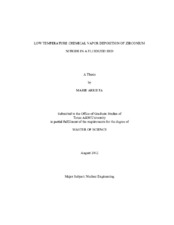| dc.description.abstract | The objective of this research was to design, assemble, and demonstrate the initial performance of a fluidized bed chemical vapor deposition (FB-CVD) system capable of producing thin, uniform zirconium nitride (ZrN) coatings (1 to 10 micrometers thick) on uranium-molybdenum (UMo) particulate fuel. Plate-type fuel with U-xMo (x = 3 to 10 wt.%) particle fuel dispersed in an aluminum matrix is under development at Idaho National Laboratory (INL) for the Reduced Enrichment for Research and Test Reactors (RERTR) program. Initial irradiation tests performed at INL in the Advanced Test Reactor (ATR) indicate an interaction layer forms between the fuel microspheres and the matrix at relatively high power levels. These power levels induce higher temperatures which enables uranium diffusion into the aluminum during irradiation, eventually causing fuel plate failure. The objective of this work was to create a process to mitigate the fuel/matrix interaction by forming a thin barrier coating on the surface of the U-xMo microspheres before incorporation into the dispersion fuel plate matrix.
One of the main challenges in performance of the FB-CVD system was the effective fluidization of a powder whose physical characteristics (size, density) are continuously changing. To address this, two types of fluidized bed reaction vessels were designed and improved over the course of this research: a spouted fluidized bed and an inverted fluidized bed. Both reaction vessels utilized tetrakis(dimethylamino)zirconium (TDMAZ) and ammonia gas as precursors at atmospheric pressure. Tungsten wires and zirconia-silica (ZrO2-SiO2) microspheres were used as the substrates for the coating experiments. The substrate temperature and precursor gas flow were manipulated as the process variables.
The FB-CVD system was successful in forming zirconium based coatings on surrogate microspheres with elevated levels of chemical impurities. At atmospheric pressure, coatings of thicknesses ranging from 0.5 micrometers to 1.5 micrometers were produced between temperatures of 250 degrees C and 350 degrees C. The deposited coatings were characterized using scanning electron microscopy, energy dispersive spectroscopy and wavelength dispersive spectroscopy. | en |


